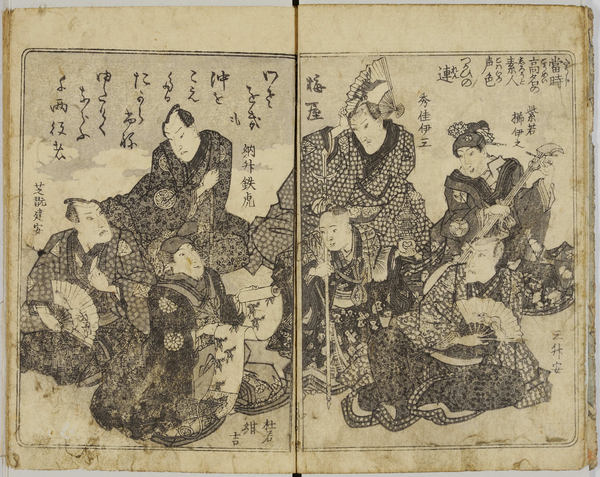G01 Appreciating Kabuki Culture
-
"Kowairo hayagaten"First chapter
Artist: Kunisada the first Author: Goryutei Tokusho Chubon, One volume
Published: 1831(Tenpo 2), in Edo
Ritsumeikan Shirakaba Collection(shiBK03-0148)While Kabuki is regarded as a traditional or classical Japanese theatrical art, during Edo and Meiji period (from 17th century to the beginning of 20th century), Kabuki was "contemporary play" for Japanese people at that time. It was the most popular entertainment just like people enjoy gossips on the web or TV in modern times, and it was almost a part of lives of ordinary people. They can enjoy Kabuki not only in theatres but also in everywhere of their daily life.
Kabuki actors and the programs on the board was keeping a focus of civilians' attention. Each time the performance season started, in large numbers of "Yakusha-e" (actor's print) was marketed on, and many people bought lots of them like a photographs of a movie star. After the season, "Yakusha hyobanki" (actor's critique) was published in every year, so people both who enjoyed the stage and who missed to watch the stage could know the contents and be entertained by such a theatre reviews.
Even more, Kabuki actors were much more sparkling existence than TV or movie actors in contemporary. The picture displayed here is a textbook for mimicking and some professional mimicry entertainers can be seen in the page. Mimicry entertainers are still applauded with their mimicking of famous actors or singers, and such a professionals have existed from Edo period.
Children also adored Kabuki. For example, Kabuki programs and heroes were major subject of picture books for kids and toys. Many of "Omocha-e" (toy print), a kind of those toys enjoyed to construct Kabuki stage diorama, still survive. Among them, there are some too complicated Omocha-e for children, it took some process such as cutting out small and numerous parts and pasting it on the right positions, those complex and relatively large-scale diorama were enjoyable for adults as well. (,)
-

- 投稿日:
- by 8P
- カテゴリ: G Amusement for Audiences
- [編集]